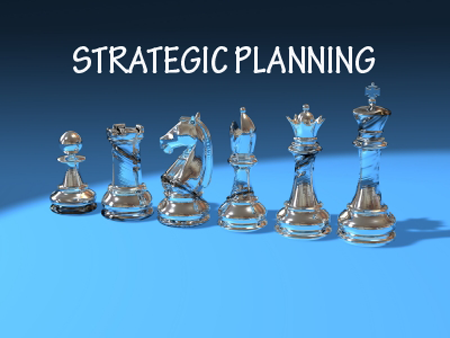In these unpredictable times, companies often find themselves running on train tracks, unaware of the impending danger of an unseen train barreling down upon them. Traditional planning methods may no longer suffice to navigate these turbulent times. Instead, a fresh approach to scenario planning can help companies anticipate potential threats and opportunities, ensuring that they are better prepared to adapt and thrive.
The Concept of Scenario Planning
Scenario planning is a strategic planning method used to make flexible long-term plans. It is not about predicting the future but about exploring different plausible futures and preparing for them. By considering a range of possible scenarios, businesses can develop strategies that are robust and adaptable, no matter what the future holds.
The Need for a Fresh Approach
The traditional methods of scenario planning, while useful, may not be sufficient in today's rapidly changing world. Factors such as technological advancements, economic shifts, geopolitical tensions, and global health crises require a more dynamic and comprehensive approach. A fresh perspective on scenario planning involves integrating new tools, technologies, and thinking patterns to better anticipate and navigate these complexities.
Benefits of Scenario Planning
Anticipating Change
One of the primary benefits of scenario planning is its ability to help organizations anticipate change. By exploring various potential futures, businesses can identify early warning signs and trends that may indicate significant shifts in the market or industry.
Enhancing Agility
Scenario planning fosters agility by encouraging organizations to think about multiple outcomes and prepare for them. This proactive mindset allows businesses to pivot quickly and effectively in response to changing circumstances.
Reducing Uncertainty
While it is impossible to eliminate uncertainty, scenario planning can significantly reduce it. By considering a range of possibilities, companies can develop contingency plans and mitigate risks associated with unforeseen events.
Improving Decision-Making
Scenario planning improves decision-making by providing a structured framework for evaluating potential risks and opportunities. This approach enables leaders to make informed choices based on a comprehensive understanding of possible future scenarios.
Implementing a Fresh Approach to Scenario Planning
Define Objectives and Scope
Before diving into scenario planning, it is essential to define the objectives and scope of the exercise. What are the primary goals? Are you focusing on market trends, technological advancements, or geopolitical risks? Clearly outlining the scope will ensure that the scenario planning process remains focused and relevant.
Gather Data and Insights
Collecting relevant data and insights is crucial for effective scenario planning. This includes quantitative data such as market trends, economic indicators, and technological developments, as well as qualitative insights from industry experts, employees, and other stakeholders.
Identify Key Drivers
Identify the key drivers that could impact your organization in the future. These drivers could be internal, such as organizational capabilities and resources, or external, such as regulatory changes and market dynamics. Understanding these drivers will help in the development of plausible scenarios.
Develop Scenarios
Developing scenarios involves creating a range of plausible futures based on the identified drivers. These scenarios should be diverse and cover a spectrum of possibilities, from best-case to worst-case scenarios. Each scenario should be detailed enough to provide a clear picture of the potential future environment.
Analyze Implications
Analyze the implications of each scenario for your organization. This includes assessing the potential risks and opportunities, as well as the impact on various aspects of the business, such as operations, finances, and human resources. This analysis will help identify areas where the organization needs to strengthen its capabilities or develop contingency plans.
Develop Strategies and Contingency Plans
Based on the analysis, develop strategies and contingency plans for each scenario. These plans should outline specific actions that the organization can take to mitigate risks and capitalize on opportunities. Having a clear set of strategies in place will ensure that the organization is prepared to respond effectively to any future developments.
Monitor and Update
Scenario planning is not a one-time exercise; it requires continuous monitoring and updating. Regularly review the scenarios and adjust the plans as needed based on new information and changing circumstances. This ongoing process will help maintain the relevance and effectiveness of the scenario planning efforts.
Real-World Applications
Case Study: Technology Industry
In the technology industry, where rapid innovation and market disruption are common, scenario planning is essential. A leading tech company can implement a fresh approach to scenario planning by incorporating data analytics and AI-driven insights. This allows them to identify emerging trends, such as the rise of quantum computing and its potential impact on their business. By developing scenarios around these trends, they are able to invest in relevant research and development, positioning themselves as leaders in the next wave of technological advancements.
Case Study: Healthcare Sector
The healthcare sector, particularly in the wake of the COVID-19 pandemic, has experienced significant upheaval. A large healthcare provider can use scenario planning to navigate the uncertainties surrounding future pandemics, regulatory changes, and technological innovations in telehealth. By developing scenarios that are considered various public health outcomes and regulatory landscapes, a forward-thinking organization can create robust strategies for patient care, resource allocation, and technological adoption, ensuring they remain resilient and responsive to future challenges.
Case Study: Financial Services
In the financial services industry, scenario planning helps organizations prepare for economic fluctuations and regulatory changes. A bank can implement scenario planning to assess the potential impacts of economic downturns, changes in interest rates, and regulatory reforms. By developing and analyzing multiple scenarios, they can create contingency plans that include diversifying their investment portfolio, enhancing risk management practices, and exploring new revenue streams. This proactive approach can enable them to maintain stability and growth even during periods of economic uncertainty.
Overcoming Challenges
Addressing Cognitive Biases
One of the main challenges in scenario planning is overcoming cognitive biases that can influence decision-making. These biases, such as overconfidence or anchoring, can lead to an over-reliance on certain scenarios and a dismissal of others. To address this, organizations should encourage out-of-the-box perspectives and critical thinking, ensuring that all scenarios are given due consideration.
Ensuring Stakeholder Buy-In
Gaining buy-in from stakeholders is crucial for the success of scenario planning efforts. This requires clear communication about the purpose and benefits of the process, as well as involving key stakeholders in the development and analysis of scenarios. By fostering a collaborative approach, organizations can ensure that scenario planning is embraced and supported at all levels.
Integrating Technology
Leveraging technology can enhance the effectiveness of scenario planning. Tools such as data analytics, AI, and simulation software can provide deeper insights and more accurate predictions, enabling organizations to develop more robust and comprehensive scenarios. Integrating these technologies into the scenario planning process can help organizations stay ahead of the curve and better prepare for future challenges.
Wrapping it up
In the new era of business, where unpredictability and rapid change are the norms, a fresh approach to scenario planning is essential. Businesses can foster resilience and adaptability by taking a fresh approach to scenario planning. The integration of technology, addressing cognitive biases, and ensuring stakeholder buy-in further enhance the effectiveness of scenario planning, positioning organizations for sustained success in an uncertain world.
Latest posts by Tresha Moreland (see all)
- A Fresh Approach to Scenario Planning: Avoiding the Unseen Train in the New Era - June 25, 2024
- Reassessing Your Department’s Effectiveness - June 24, 2024
- The Emergence of the Skills-Based Organization - June 23, 2024












